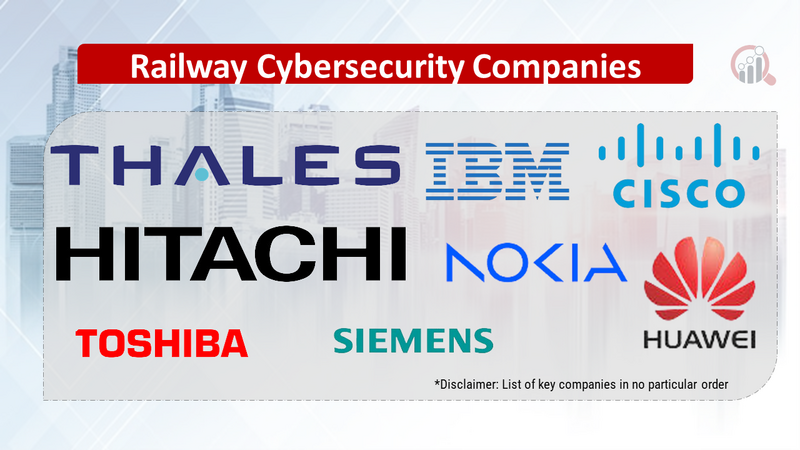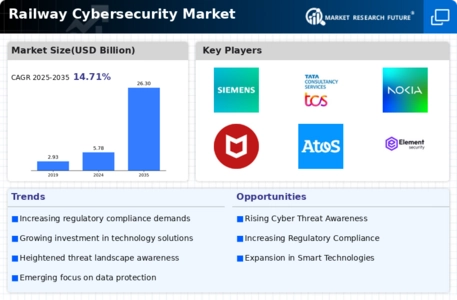Top Industry Leaders in the Railway Cybersecurity Market

Railway Cybersecurity Market: Dive into the Latest News and Updates
The iron horse of yesteryear has morphed into a digital marvel, with modern railways pulsating with interconnected systems, advanced sensors, and real-time data flows. This technological leap forward, however, introduces a new frontier of vulnerability – the Railway Cybersecurity Market.
Some of Railway Cybersecurity Companies Listed Below:
- Thales Group (France)
- Siemens AG (Germany)
- Alstom (France)
- Wabtec Corporation (US)
- Hitachi, Ltd. (Japan)
- Nokia Networks (Finland)
- IBM (US)
- Cisco Systems, Inc. (US)
- Raytheon Technologies Corporation (US)
- Huawei Technologies Co., Ltd. (China)
- Toshiba Corporation (Japan)
Strategies Fueling Growth:
- Risk-Based Approach: Identifying critical assets, assessing vulnerabilities, and prioritizing investments based on potential impact of cyberattacks guides efficient resource allocation and targeted security measures.
- Zero-Trust Security Model: Implementing a layered security approach with least-privilege access controls, network segmentation, and continuous monitoring minimizes attack surfaces and restricts attacker movement.
- Threat Intelligence and Incident Response: Leveraging industry expertise, threat intelligence feeds, and robust incident response plans enables railways to proactively identify and mitigate cyber threats.
- Collaboration and Knowledge Sharing: Partnerships with cybersecurity vendors, government agencies, and other railways foster knowledge sharing, best practices adoption, and coordinated responses to emerging threats.
Market Share Decoding: Key Factors to Consider:
- Portfolio Breadth and Feature Set: Providers offering comprehensive solutions including network security, endpoint protection, threat intelligence, and incident response services cater to diverse cybersecurity needs and attract wider interest.
- Industry Expertise and Domain Knowledge: Companies with deep understanding of railway systems and operational challenges can tailor their solutions for specific security vulnerabilities and ensure seamless integration with existing infrastructure.
- Track Record and Case Studies: Proven success stories, demonstrated expertise in incident response, and positive reputation within the railway industry build trust and attract potential clients.
- Compliance and Regulatory Adherence: Adherence to international railway cybersecurity standards and national regulations assures clients of commitment to secure operations and data privacy.
New and Emerging Stars: Illuminating the Cybersecurity Path:
- Artificial Intelligence and Machine Learning: Startups like Deepwatch and Cylance integrate AI and ML into their railway cybersecurity solutions for anomaly detection, predictive maintenance, and automated threat response.
- Blockchain-Powered Supply Chain Security: Companies like Skuchain and Symbion explore blockchain technology for securing railway equipment supply chains, preventing component counterfeiting, and ensuring system integrity.
- IoT Security and Endpoint Protection: With the increasing number of sensors and connected devices on trains, startups like Palo Alto Networks and Crowdstrike develop specialized endpoint protection solutions to secure onboard systems and communication channels.
Investment Trends: Where the Railway Cybersecurity Dollars Flow:
- Cloud-Based Security Platforms: Investors are backing companies developing scalable and easily deployable cloud-based cybersecurity solutions tailored for railway operations, offering cost-effective and efficient security measures.
- AI-Powered Threat Intelligence and Detection: Startups leveraging AI and ML for advanced threat detection, vulnerability assessments, and proactive risk management attract significant investment for their potential to prevent cybersecurity incidents before they occur.
- Incident Response and Cyber Insurance Solutions: Companies offering specialized railway incident response services and cyber insurance tailored for railway risks garner investor attention as demand for rapid response and financial protection grows.
Latest Company Updates:
October 31, 2023:
- Cybersecurity attack on Belgian Railways disrupts operations: This incident highlights the potential for cyber threats to impact critical infrastructure.
- Focus on risk management: Railway operators are developing comprehensive risk management strategies to identify, assess, and mitigate vulnerabilities.
November 15, 2023:
- Collaboration and information sharing: Industry stakeholders are working together to share threat intelligence and best practices for cybersecurity defense.
December 6, 2023:
- EU Agency for Railways calls for mandatory cybersecurity standards: This proposal aims to raise the bar for cyber defenses across European rail networks.
- Focus on secure communication protocols and network segmentation: Implementing robust security protocols and segmenting networks are crucial for preventing attackers from spreading through systems.
January 8, 2024:
- AI and machine learning (ML) integration for threat detection and anomaly identification: Utilizing AI and ML algorithms can help predict and prevent cyberattacks in real-time.
- Focus on workforce training and awareness: Educating employees about cybersecurity best practices and protocols is essential for building a strong defense.
January 9, 2024:
- Increased adoption of incident response plans and cyber insurance: Having a plan in place to respond to cyberattacks and insurance to cover potential damages is crucial for minimizing disruption and financial losses.
- Focus on physical security and access control: Securing physical access points and implementing robust access control measures are key to preventing unauthorized access to critical infrastructure.









